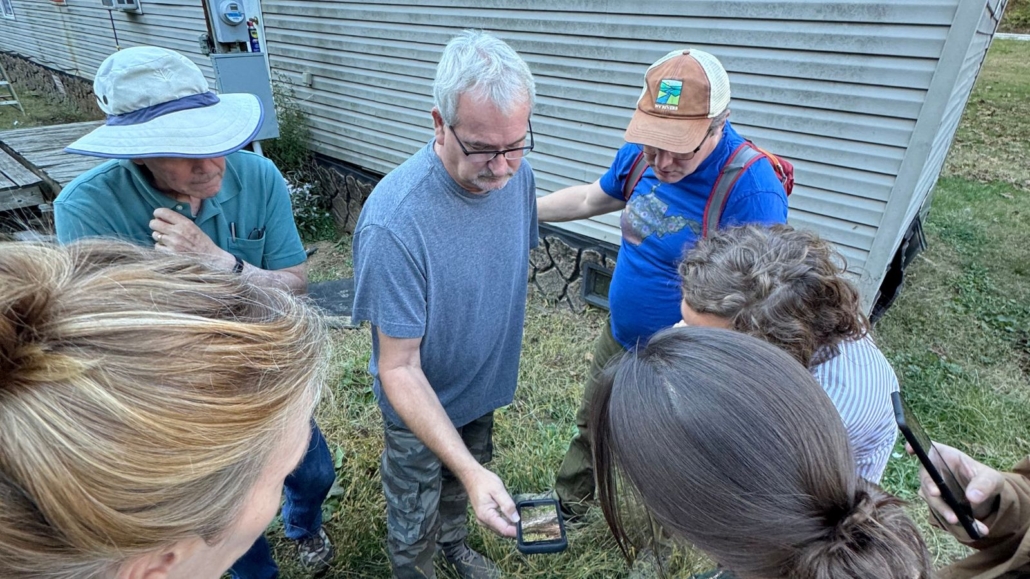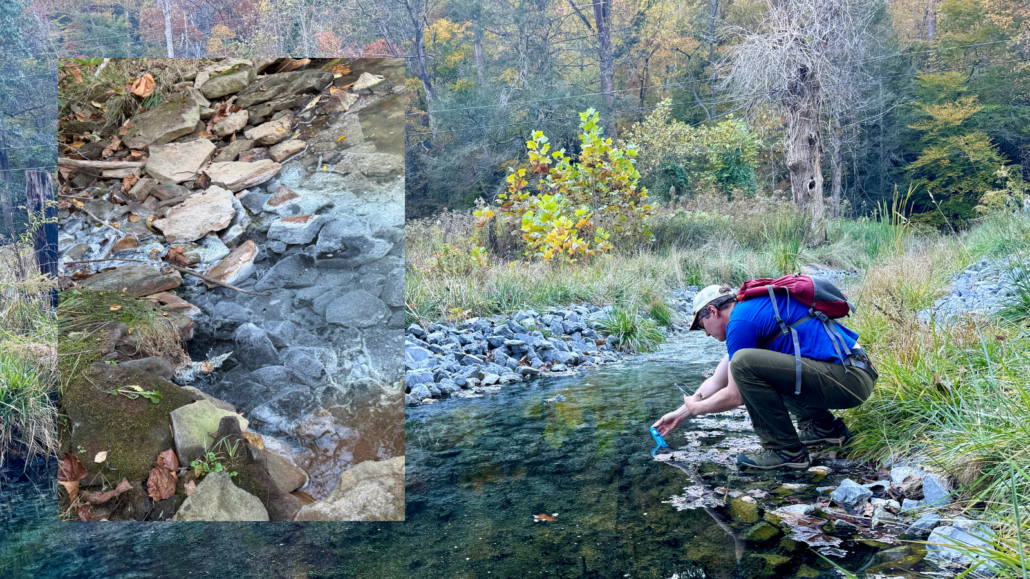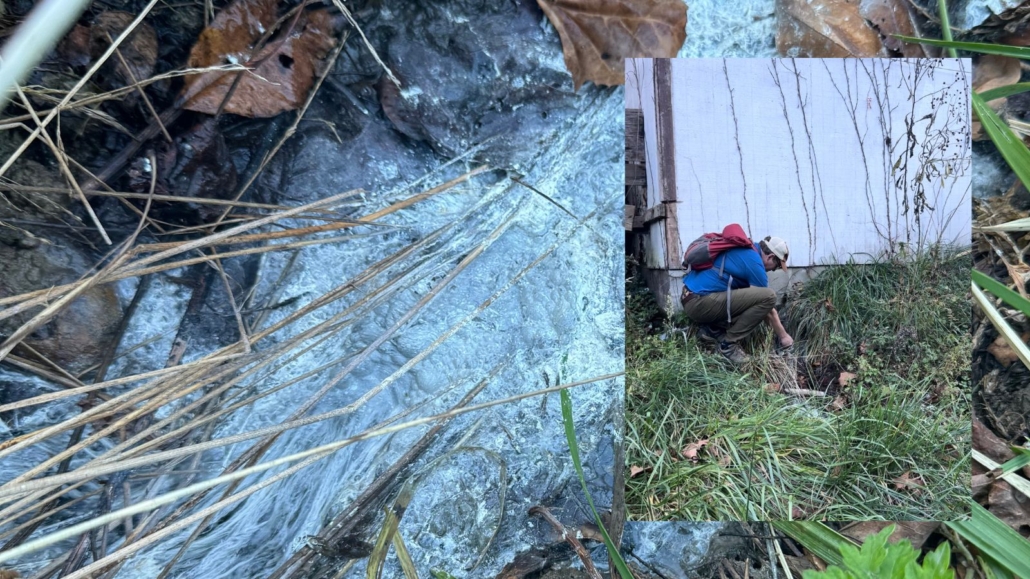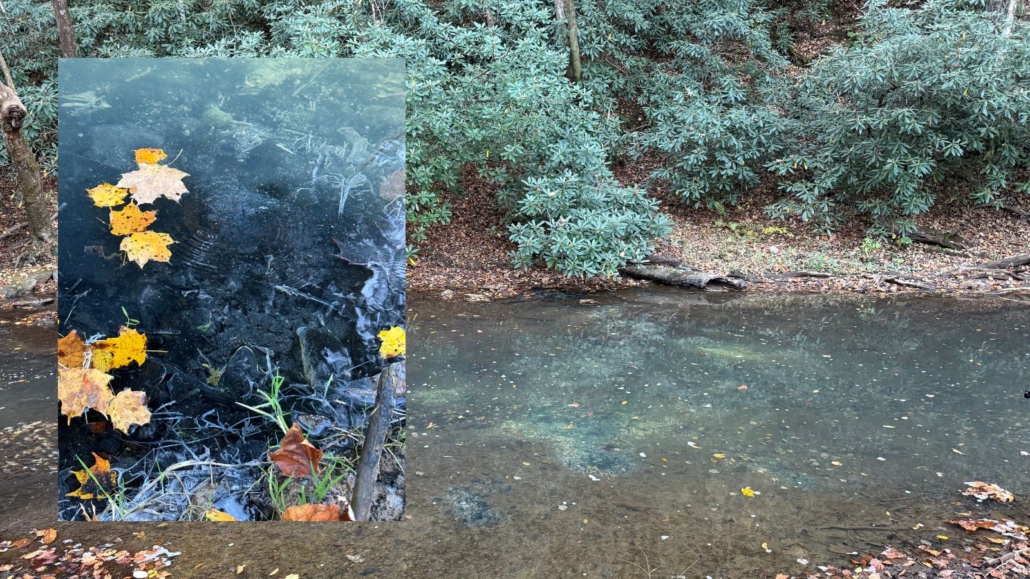Indian Creek: A Community’s Struggle for Clean Water
Members of the West Virginia Rivers Coalition team gather around to look at a video on community member Richard Altizer’s phone. The video showed what the location the team was observing looked like in February of 2023.
This fall, our team at West Virginia Rivers Coalition met up with a community member in the parking lot outside of the lodge at Twin Falls State Park in Wyoming County, West Virginia.
Richard Altizer planned to show us a 3-mile stretch of Indian Creek so we could hear from his friends and neighbors who live alongside it. He’d given this tour many times before, to anyone who would listen with the hope they would help his friends and neighbors – and he’s documented it on his personal Facebook since February 2023.
Our visit to Indian Creek revealed a lifeless stream and a community grappling with severe health risks linked to contamination while three mining companies argue in court over who is responsible.
Image of Senior Scientist Than Hitt collecting a conductivity reading from a source of pollution impacting Indian Creek. There is another image overlaid that shows another area of the creek impacted.
Following our visit, WV Rivers Coalition submitted a detailed report to the West Virginia Department of Environmental Protection (WVDEP), urging immediate investigation and remediation. Here is what we observed:
Our first stop was at Jamie and Tina Christian’s home, where water began bubbling up from behind their house, flooding their yard on February 21, 2023.
Dan Radmacher with Appalachian Voices reported, “The West Virginia Department of Environmental Protection sent an inspector to look into what was happening. He concluded the water was being forced out of the ground by internal pressure — known as “artesianing” — because of what was then an unauthorized discharge of coal mine water from the nearby Pinnacle Mining Complex (Pinn MC) into an inactive underground mine. Underground mines in this area require constant pumping to keep from flooding.”
The inspector with WVDEP ordered Pinn MC Wind Down Co. to address discharges in 2018. Still, court delays and disputes over mine ownership between Pinn MC Wind Down Co., Bluestone Resources, and Alpha Natural Resources have left the pollution unaddressed.
Next, the water began to surge out of an old artesian well on the edge of the property, flowing continuously on the surrounding land and, eventually, into the creek. West Virginia Rivers Coalition’s Senior Scientist Than Hitt made two observations at and above the National Pollutant Discharge Elimination System (NPDES) permit WV009000 outlet 118.
The conductivity within WV009000 outlet 118 water was 1,159 microSiemens per centimeter (µS/cm). In contrast, the conductivity of Indian Creek ~10 meters upstream from the confluence with this discharge point was 628 µS/cm. A stringy, white precipitate material – or residue – was visible in the discharge from outlet 118, and it covered much of the substrate. The visible precipitates extended past a ditch and directly into Indian Creek downstream. The water passed over rock, ground, and through the six hay bales placed in the output as a mitigation attempt.
For context, Than shared, “A healthy stream in this region would be somewhere between 50 and 100 µS/cm. This means there is a massive amount of dissolved material like we’ve seen in mine water discharge elsewhere.”
Further down the road, water spews from the foundation of another home and into Indian Creek. No NPDES signage was present. One resident living there had lost her voice entirely, while another had experienced significant weight loss over the past several months.
The stringy, white precipitate material – or residue – below covers much of the substrate surrounding contamination spilling out of the foundation of a home. Our Senior Scientist Than Hitt conducted a conductivity reading of the fluid coming out of the home.
At this location, the conductivity meter was off the scale. We watched as Than took an initial reading and shook his head. He waited a moment and then retested at the source. A colleague asked how much.
“It’s off the scale,” Than remarked. “I haven’t seen that. It’s over 2,000 units, so it’s totally loaded with dissolved material.”
As we followed the creek, the evidence of contamination became undeniable. Indian Creek exhibited a cloudy/milky appearance throughout the area, and this discoloration increased downstream of the artesian well near the Christian’s home.
Another stretch of creek, with cloudy water and contamination visible. In the creek, there are areas where methane bubbles up from the creekbed, escaping the mine below.
Some areas of the creek were unnaturally still, with a slick, oily sheen. A white precipitate material was visible in the discharge, covering much of the substrate elsewhere. We also observed areas with a black stream bottom, where bubbles continuously form from beneath the ground. The air smelled strongly of rotten eggs, an odor signaling the presence of hydrogen sulfide, and clearly was coming from the polluted water. It’s important to note that hydrogen sulfide exposure presents significant risks to public health and the environment.
In March, Mike Tony with Charleston Gazette-Mail reported, “State legislators gave no response on the floor of the House of Delegates when Assistant Majority Whip Adam Vance, R-Wyoming, and an underground coal miner, begged for help in a March floor speech.”
In that speech, Delegate Vance advocated for his community, stating the well water in the area was contaminated and that two people in the community died from, and five were diagnosed with cancer in the past year.
Even limited exposure to hydrogen sulfide can make you feel bad. After about an hour, members of our team expressed nausea, headaches, and dizziness. Other symptoms, according to the Agency for Toxic Substances and Disease Registry, can include eye irritation, respiratory irritation, vomiting, and, in cases of prolonged exposure, unconsciousness and death.
The absence of life in this creek is enough to stop you in your tracks, and the plants and roots appear to reach almost away from the water despite drought conditions. An abandoned dam sits above a toxic water hole, and Richard tells us the beavers have been gone for months.
Families along Indian Creek have gone over a year without safe water for drinking, cooking, or bathing. The community has rallied, organizing water deliveries to meet basic needs, but long-term support is critical to see them through the winter. What’s needed most urgently:
- More clean drinking water and safe containers.
- Portable water buffalo tanks and storage units to prevent freezing.
- Accessible showers for those without clean water at home.
- Volunteers to help deliver water to the most impacted families.
- Communities shouldn’t bear the cost of this crisis. WV Rivers urges officials to hold polluters accountable, but in the short term, public support is crucial. If you’d like to help monetarily, visit the Indian Creek Water Distribution GoFundMe to support these efforts.
When environmental safeguards fall short, the impact is deeply personal – affecting health, livelihoods, community ties, and the essential need for safe water. The contamination on Indian Creek is a stark reminder of the long-term consequences of industrial and extractive activity, where communities are left to bear the brunt of pollution while those responsible avoid accountability.
West Virginians have a deep connection to their water and land. They take care of each other in times of need. However, no community should have to rely on mutual aid to provide their community with safe water as a result of the industry’s and their regulator’s negligence.
This winter, we hope you’ll join us in supporting the people of Indian Creek as they navigate this crisis. Together, we can ensure they have the resources they need now and advocate for lasting solutions to hold polluters accountable.
Click here to help and share this story to amplify the needs of those living along Indian Creek.
For clean water & healthy communities,
WV Rivers Coalition






